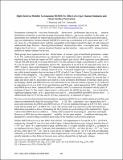| dc.contributor.author | Hennessy, J. | |
| dc.contributor.author | Antoniadis, Dimitri A. | |
| dc.date.accessioned | 2010-10-15T15:37:20Z | |
| dc.date.available | 2010-10-15T15:37:20Z | |
| dc.date.issued | 2009-12 | |
| dc.date.submitted | 2009-06 | |
| dc.identifier.isbn | 978-1-4244-3528-9 | |
| dc.identifier.other | INSPEC Accession Number: 11010504 | |
| dc.identifier.uri | http://hdl.handle.net/1721.1/59374 | |
| dc.description.abstract | Germanium n-channel devices have historically shown poor performance due to an asy mmetric distribution of interface st ates that degrade electrostatic behavior and carrier mobility. In this study we demonstrate two methods for improving the performance of Ge nFETs, ozone surface passivation and ntype ion-implantation. Surface-channel nMOSFETs receiving a combination of O[subscript 3] passivation and 1*10[superscript 12] dose As or Sb implants show mobility comparable to the highest reported to date with improved subthreshold slope. Devices showing buried-channel characteristics show even higher peak mobility (higher than Si at low in version densities) illustrating that interface states are still limiting electron mobility in surface-channel Ge devices. | en_US |
| dc.description.sponsorship | United States. Defense Advanced Research Projects Agency. Focus Center Research Program (MSD Focus Center) | en_US |
| dc.language.iso | en_US | |
| dc.publisher | Institute of Electrical and Electronics Engineers | en_US |
| dc.relation.isversionof | http://dx.doi.org/10.1109/DRC.2009.5354921 | en_US |
| dc.rights | Article is made available in accordance with the publisher's policy and may be subject to US copyright law. Please refer to the publisher's site for terms of use. | en_US |
| dc.source | IEEE | en_US |
| dc.title | High electron mobility germanium MOSFETs: Effect of n-type channel implants and ozone surface passivation | en_US |
| dc.type | Article | en_US |
| dc.identifier.citation | Hennessy, J., and D.A. Antoniadis. “High electron mobility germanium MOSFETs: Effect of n-type channel implants and ozone surface passivation.” Device Research Conference, 2009. DRC 2009. 2009. 257-258. © Copyright 2009 IEEE | en_US |
| dc.contributor.department | Massachusetts Institute of Technology. Department of Electrical Engineering and Computer Science | en_US |
| dc.contributor.department | Massachusetts Institute of Technology. Microsystems Technology Laboratories | en_US |
| dc.contributor.approver | Antoniadis, Dimitri A. | |
| dc.contributor.mitauthor | Hennessy, J. | |
| dc.contributor.mitauthor | Antoniadis, Dimitri A. | |
| dc.relation.journal | Device Research Conference, 2009. DRC 2009 | en_US |
| dc.eprint.version | Final published version | en_US |
| dc.type.uri | http://purl.org/eprint/type/JournalArticle | en_US |
| eprint.status | http://purl.org/eprint/status/PeerReviewed | en_US |
| dspace.orderedauthors | Hennessy, J.; Antoniadis, D.A. | en |
| dc.identifier.orcid | https://orcid.org/0000-0002-4836-6525 | |
| mit.license | PUBLISHER_POLICY | en_US |
| mit.metadata.status | Complete | |
